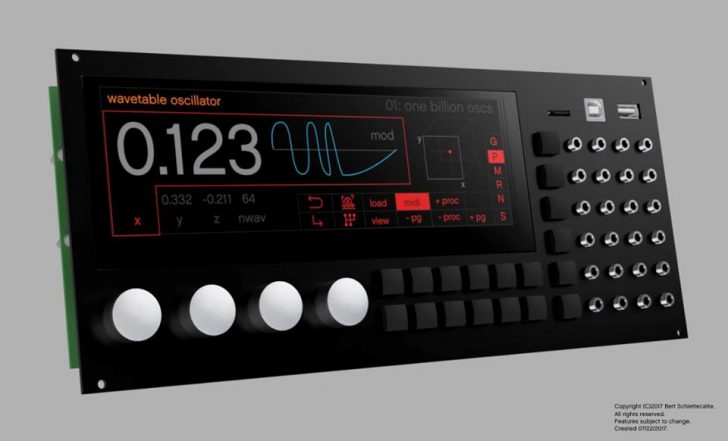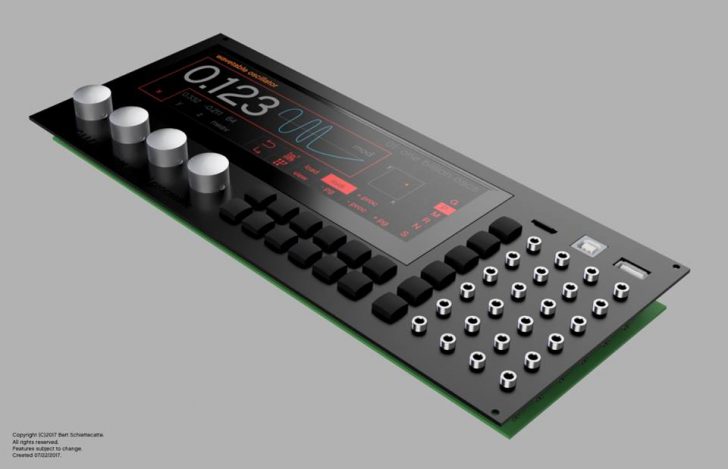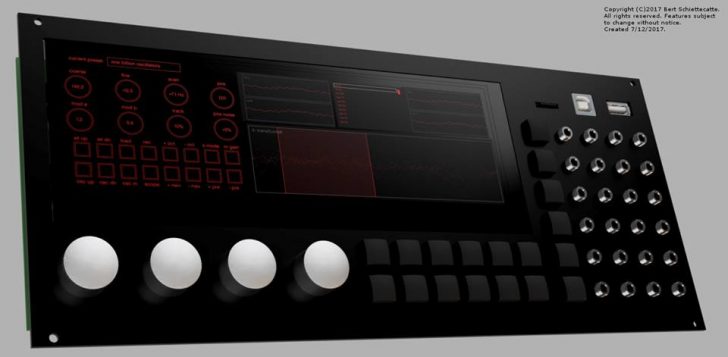Digital oscillators – like the Mutable Instruments Braids, Synthesis Technologies Quad Morphing VCO & the Radikal Technologies Swarm Oscillator – have become some of the hottest modules in the Eurorack format.
Now AudioCubes creator Bert Schiettecatte of Percussa is teasing a Super Signal Processor (SSP) Euro module that’s sort of a futuristic take on the Moog Mother-32.
The planned module features a large screen, patch points on the right side of the module like the Mother-32, and controls that dynamically map to the module’s features. It will be able to be used as a Super Wavetable Oscillator and a variety of other DSP functions.
Here’s what Schiettecatte has to say about the module’s hardware:
This processing platform is one of the fastest ARM platforms available for synthesis. With its 4 cores running at 1.8GHz, it achieves about 28,800 DMIPS of processing power. Common processors in Eurorack modules are the single core Cortex M4 and M7 processors, which at their highest clock frequencies of around 200MHz stay below 500 DMIPS. Less common processors in Eurorack modules are the single core Cortex A8 at 1GHz, which offers around 2,000 DMIPS of processing power.
Because of the processing power it offers, this “super oscillator” will actually support running around 64 wavetable oscillators in parallel, and with sample rates up to 192kHz with 32 bit resolution. All processing is done using 32-bit floating point precision with 64-bit precision where necessary.
You will be able to chop up the samples you load to create different wavetables on the fly. The software will support scanning the wavetables in various ways with of course modulation possibilities using the CV jacks. In the mockup you can see that the encoders are mapped to coarse/fine pitch, scanning direction, position, keyboard tracking, position noise, and mod A and B which can be additional oscillator parameters depending on oscillator mode. The pushbuttons can be used to choose wavetables, step through the oscillators, change presets, etc.
The module will come with a 1600×480 pixel IPS display, full colour, and high-end AKM ADC and DAC (stereo in and 6 channel out). The display tells you what the push buttons and encoders of the module do. The modules have no printing on the jacks, buttons or rotary encoders because all that info is shown on the screen. The screen is NOT a touchscreen.
In addition to these high resolution/sample rate DAC/ADC chips there will be 16-bit ADCs to sample CV inputs (there are 24 connectors on the front site, 18 of which will be CV or gate inputs, configurable via the software to control pitch of oscillators or the various parameters of the oscillators). The stereo high resolution input can be used for sampling or to modulate parameters of the oscillators.
The module has high resolution endless and clickless rotary encoders (bourns) and high quality MEC switches (industrial type). The encoders have aluminium knobs on them, clear anodisation.
There will also be support for storing presets, and multiple oscillator modes. This way you can store many different routings between oscillators and input and output jacks and recall them with the press of a button.
The input signals will be routable to the oscillators however you want, and the output signals from the oscillators can be routed to other oscillators internally via software or sent out via the 6 output channels.
Schiettecatte also shared this preview of the 3D Morphing/modulation capabilities of the Percussa Engine Synthesizer’s Wavetable Oscillator. In the video you can see multiple wavetable oscillators (orange) modulated by multiple LFOs (green):
The module’s cloud feature will support up to 16 oscillator copies per WT oscillator, with controllable/modulatable spread,
Pricing and Availability
The Percussa Super Signal Processor (SSP) is still in the design stages, so pricing and availability are to be determined. Schiettecatte is planning a Kickstarter project to fund production of the module. You can follow the module’s development via Schiettecatte’s Facebook page.
Note: This post has been updated to reflect the current name for the planned module. The module was originally planned as a Super Wavetable Oscillator, but the module’s scope has been expanded to support a variety of functions and the name has been updated to reflect that.







Well, I don’t exactly get the thing here.
It’s always nice to have more oscillators available for Eurorack, sure.
But I’d say it’s not exactly a selling point when you say “okay, it’s got a 192kHz sampling rate”. This is just too much for Eurorack.
And comparing pure horsepower to other modules, that don’t have the same aim at all, is not really relevant here. Algorithms make the sound, not the hardware. There’s not point in this comparison.
I’d rather see one complete synth voice (with that MCU, it’s clearly possible) than a monolithic, big overkill wavetable oscillator (plus, 64 oscillators, that’s impressive, okay… But why?).
192kHz is not too much, it’s finally enough to avoid audible aliasing. I’m thrilled at this new generation of digital oscillators using high sample rates, Shapeshifter and Peak are up in the MHz. The Oscillators in the Modal 002 are a few kHz and even the Solaris, new Clavia stuff and Braids are 96kHz or higher.
People finally know what aliasing is, why it sounds bad when it’s just from a static low sample rate like 44.1kHz and DSP is finally powerful enough to run at the speeds necessary to eliminate it.
Death to uncontrolled Aliasing!
The problem is that with 192kHz, you creating new aliasing too… because of imprecision of clocks (there’s a reason we use high-end 5 grand clock in studio to get converters properly working in sync).
It has been debated many times already, but there’s no point of 192kHz, not even for sampling, and surely not on mass produced product that won’t have very high-end quality converters. This has been explained and proved already:
http://www.lavryengineering.com/pdfs/lavry-white-paper-the_optimal_sample_rate_for_quality_audio.pdf
And of course, the well known studies and videos:
https://wiki.xiph.org/Videos/A_Digital_Media_Primer_For_Geeks
https://wiki.xiph.org/Videos/Digital_Show_and_Tell
https://people.xiph.org/~xiphmont/demo/neil-young.html
Higher is not always better, definitely not when no human beings can’t hear above 22kHz anyway… 44.1kHz is enough for any recording and conversion. And 96kHz is enough for any sampling. So in the case of analog synth, there’s absolutely no need of 192kHz, but also, 192kHz wouldn’t be better than 96kHz, it would actually be worse… surely in a mass produced product that won’t have converter as good as the ones we could get from Lavry.
And before to respond with your personal feelings and opinions, go study those links and come back with real scientific and proven arguments. So far, no one brought any solid arguments against Lavry or Monty Montgomery .
The idea that a lower sample rate is beneficial only applys to recording and the subsequent pass through AD and DA converters. In regards to digital signal generation it is of maximum benefit to have a sample rate that keeps any of the higher harmonics from folding back.
Some beautiful sounding synths have used super high sampling rates to avoid this problem like the PPG, Modal 002, Peak. Even most new VST’s are oversampled many times for the same reasons. Synths like Diva and Bazille default to oversampling and sound much worse when running in a lower mode. Cytomic’s circuit modelled VST’s can be oversampled to 2.8mHz for maximum fidelity. Very important in FX like that as they can produce many new harmonics as the signal is overdriven and that would sound like shit at a low sample rate.
Nope! It’s like using a 4K camera to watch it in 360p on Youtube… it brings nothing better. What would matter is the lenses first and then having a resolution that is high enough to exceed human vision (Retina Display kind of stuff). This is the same thing with audio. That’s why oversampling could be useful, but you already oversampling at 44.1kHz (since you can’t hear passed 22kHz anyway), and then you’re oversampling AGAIN at 96kHz… it won’t bring a signal more smooth and more pleasant… or free of aliasing. That’s pure b.s…. as much as gold plated connector for idiotphiles!
Even Dave Smith already explained it in a video that even with a very low scale such 128 steps with midi, we can get a smooth signal with no aliasing. Doubling resolution won’t help as much as knowing how to get a proper signal in the first place!
But hey… keep believe it!
Whatever helps you sleep at night…
You’re ignoring audio rate modulation – which higher sampling rates definitely benefit.
And Dave Smith defends the MIDI spec by saying that synths should interpolate between the 128 steps to avoid stair-stepping.
That’s not the same as saying you can’t hear more than the 128 steps – it’s saying you CAN hear it and synths should be designed to work around that.
The big limitation of low-resolution encoding is that you can’t dial in parameter more accurately than the 16, 128, etc steps that the synth was designed with. On older Dave Smith synths, this is a massive liability that anybody can hear.
give spidouz a break. he just learned a bunch of new stuff in collage and wants to apply it. in a completely irrelevent context.
i mangle the living jesus out of acoustic instruments inside computers, and the difference in processing *internally in the machine through the signal chain* is beyond obvious at high sample rates. everyone knows this. something like this i would definitely use if my plan of “outsourcing” some (or all?) of the system pans out. anyway poor guy just really doesn’t have a handle on the things he’s ranting about. lavry, heh.
All DSI synths have generous support for wide-range NRPNs to control internal values remotely. Just saying.
Aliasing csn be avoided at 96kHz and higher. 192kHz has other benefits beyond aliasing.
“This is just too much for Eurorack.”
This thing is designed to be a Cadillac module – not a Yugo.
It’s like the Synth Tech Quad VCO – not everybody can afford something like that, but if you can, it will be a beast.
(plus, 64 oscillators, that’s impressive, okay… But why?).
But why not?
agreed lol..
i can use 64 oscillators easy. 2-3 per voice and i want to play a large continuing chordal phrase with long-release ? that many would be used up quick.
For when you absolutely refuse to hook a computer up to your modular.
Coming soon: Eurorack format touchscreen tablet running Windows.
I see some real SFX design potential with this module. To bad nothing like this exists for 5U. I wonder what it would take to make a 5U version?
10 times the number of buyers?